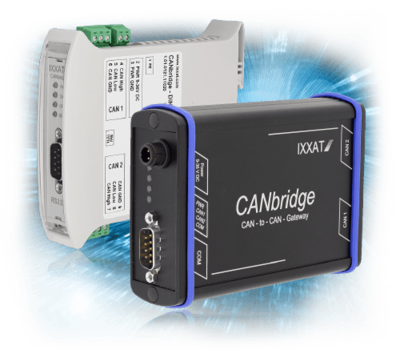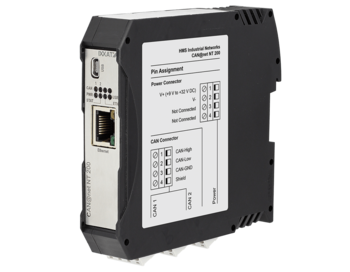IXXAT Bridges GWs
Manufacturer
Description
The use of bridges and gateways opens up a large number of configuration possibilities. For example, CAN systems can be implemented over a larger area, devices without CAN interfaces can be connected to CAN systems or CAN systems can be coupled using different technologies, such as Bluetooth, Ethernet or PROFINET.
Highlights
- Cost savings due to simple wiring
- Larger system expansion and increased system reliability
- Filter and conversion functionality
- Bridging of large distances and easy system access using Bluetooth, Ethernet, PROFINET...
How it works
CAN bridges and CAN gateways are infrastructure components with which complex network structures can be implemented.
- CAN Bridge
- A CAN bridge can connect CAN networks of different bit rates or protocols with each other. It is based on the store-(modify)-forward principle where CAN messages are received by a sub-network and then transmitted to the other sub-network. Translation and filter rules can also be used, allowing a protocol adaptation to be carried out between the sub-networks.
- Unlike the CAN repeater, the CANbridge enables the enlargement of the maximum network size so that the sub-systems are fully self-sufficient with regard to bus arbitration. Independent of each other in terms of their real-time behavior, CAN sub-networks connected by bridges are to be regarded as independent networks.
- The bridge function can also be executed with the aid of other transmission systems. For example, the CAN-Ethernet-CAN bridge is connected via two Ethernet-TCP/IP gateways which enable connection to remote CAN networks.
- CAN Gateways
- As an extension to the CAN bridges, CAN gateways allow for access to CAN networks via other communication systems. In each case, the protocols of the connected bus systems are mapped to the other communication model.
CANbridge NT and CAN @ net NT - innovative features customers ask for
With its latest devices CANbridge NT 200/420 and CAN@net NT 200/420, IXXAT extended its bridge / gateway portfolio, using a common firmware platform.
In contrast to the already available bridges / gateways, the new devices offer up two (NT 200) respectively four (NT 420) CAN interfaces.
The 4-channel variants allow to switch two „classic" CAN channels to CAN-FD, thus enabling simple coupling of CAN and CAN FD systems and devices.
The possible use case scenarios are manifold; a detailed description of the devices and application scenarios can be found on the IXXAT website.
Highlights CANbridge NT and CAN@net NT
- Up to 4 CAN channels (2x CAN-FD*) in one device
- Powerful filter, ID translation, data mapping and multiplexing functionality
- Automatic baud rate detection ** or manual configuration
- Easy configuration using Windows-based tool
(*: only valid for CANbridge NT 420 and CAN@net NT 420; **: for "classic" CAN)
State
available
Picture
External links
- IXXAT Bridges & Gateways
- detailed description of the devices and application scenarios CANbridge NT respectively CAN@net NT.
- Case study Safe elevators with IXXAT technology



